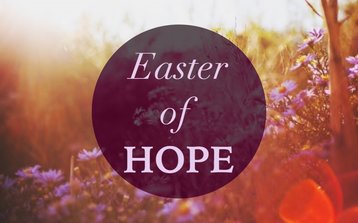Matthew 28:1-10
After the sabbath, as the first day of the week was dawning,
Mary Magdalene and the other Mary came to see the tomb.
And behold, there was a great earthquake;
for an angel of the Lord descended from heaven,
approached, rolled back the stone, and sat upon it.
His appearance was like lightning
and his clothing was white as snow.
The guards were shaken with fear of him
and became like dead men.
Then the angel said to the women in reply,
"Do not be afraid!
I know that you are seeking Jesus the crucified.
He is not here, for He has been raised just as He said.
Come and see the place where He lay.
Then go quickly and tell His disciples,
'He has been raised from the dead,
and he is going before you to Galilee;
there you will see Him.'
Behold, I have told you."
Then they went away quickly from the tomb,
fearful yet overjoyed,
and ran to announce this to His disciples.
And behold, Jesus met them on their way and greeted them.
They approached, embraced his feet, and did him homage.
Then Jesus said to them, "Do not be afraid.
Go tell my brothers to go to Galilee,
and there they will see me."
The first few days after a great tragedy are always marked with a profound silence, but a silence that feels incredibly empty, like a void. There may be chaos all around, but inside of the one feeling grief, there is a silent absence. As the women approached the tomb, they were probably silent, feeling incredibly empty, a void where Jesus’ presence used to be. It was only a “great earthquake” that shook them from their sorrow; the second earthquake since the one that had signified Jesus’ death. An angel appears, the earth shakes, the guards pass out in terror, but the women are told not to be afraid. The angel announces that Jesus is alive and Scripture says that, “they went away quickly from the tomb, fearful yet overjoyed, and ran to announce this to his disciples.” Grief becomes amazement, sorrow becomes joy. God literally shook them out of their mourning and filled them with cause to rejoice. Like the two women, none of us can escape the pain of grief and sorrow in our lives. Loss is like a “great earthquake”. It completely shakes up our lives. Nothing remains the same after an earthquake; the ground takes on a new dimension. Loss, pain, tragedy, and suffering are a part of our experience in this broken world, but in the Resurrection story we find evidence of how God confronts us in our loss and offers us hope and redemption.
The reaction of the guards and the women to the angelic presence represent the two ways we can approach tragedy. There are those who face grief with anger, trying to guard and defend what little they feel they have left, not reaching out to God in any way. When confronted with God’s grace and desire to heal them, they harden their hearts, are overwhelmed, and “become like dead men”, insensible to God’s love. The women, however, trust in God. They remained with Jesus throughout His sufferings and came to render Him service even after His death. They could not see Him in their pain, but they believed He was somehow with them. When they met the angel, although it was difficult and caused them fear, they remained steadfast and were consoled in their sorrow. More than that, Jesus entered into their very experience and revealed Himself to them, and entrusted them with a mission to announce the good news of His Resurrection to others.
Each of us has a choice when faced with suffering and grief: will we resist God, guarding ourselves from Him, and not allow Him into our pain and sorrow, or will we open our hearts and share our experience with Him? Those who trust in God will encounter Him on the path of life, in beautiful and difficult moments, and if we allow Him into our pain and sorrow, He will share with us the joy of His Resurrection. Once transformed by His Resurrection, He sends us out, like the women, to tell others that they, too, can see Him in their pain, if only they desire. Today, let us reflect on whether we approach grief like the guards or the women, for this will determine whether or not we are open to the joy of the Resurrection that we celebrate every Easter and which can break through the darkness of the deepest sorrow, if only we desire.


 RSS Feed
RSS Feed


